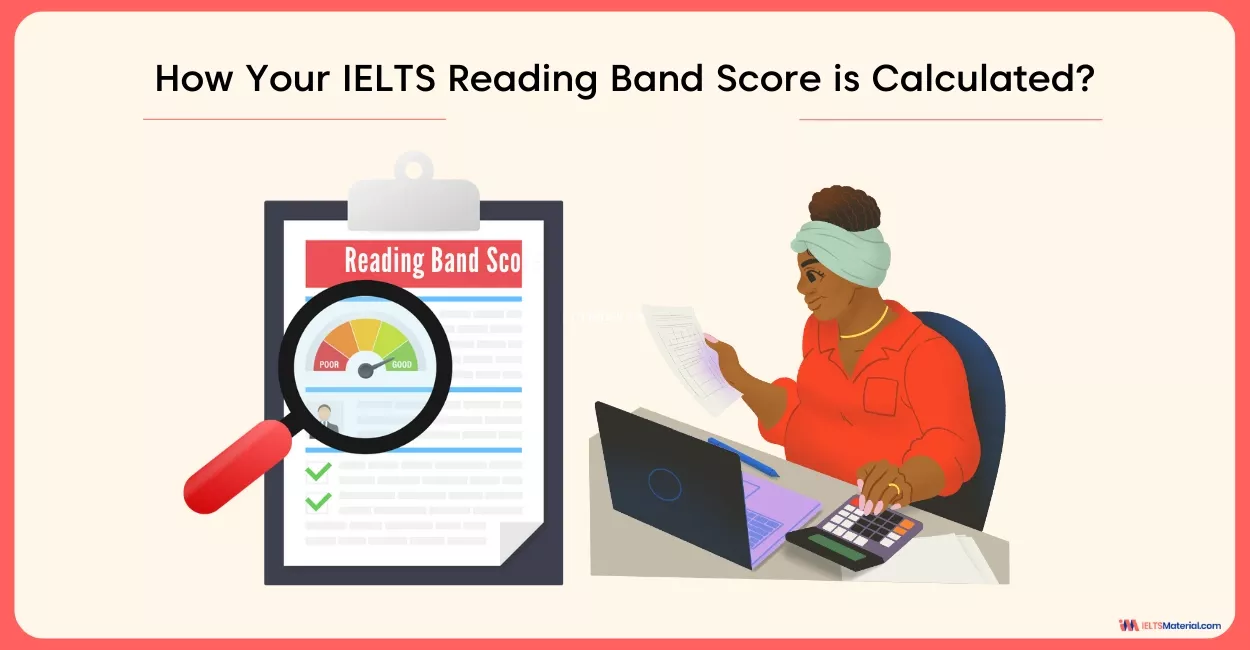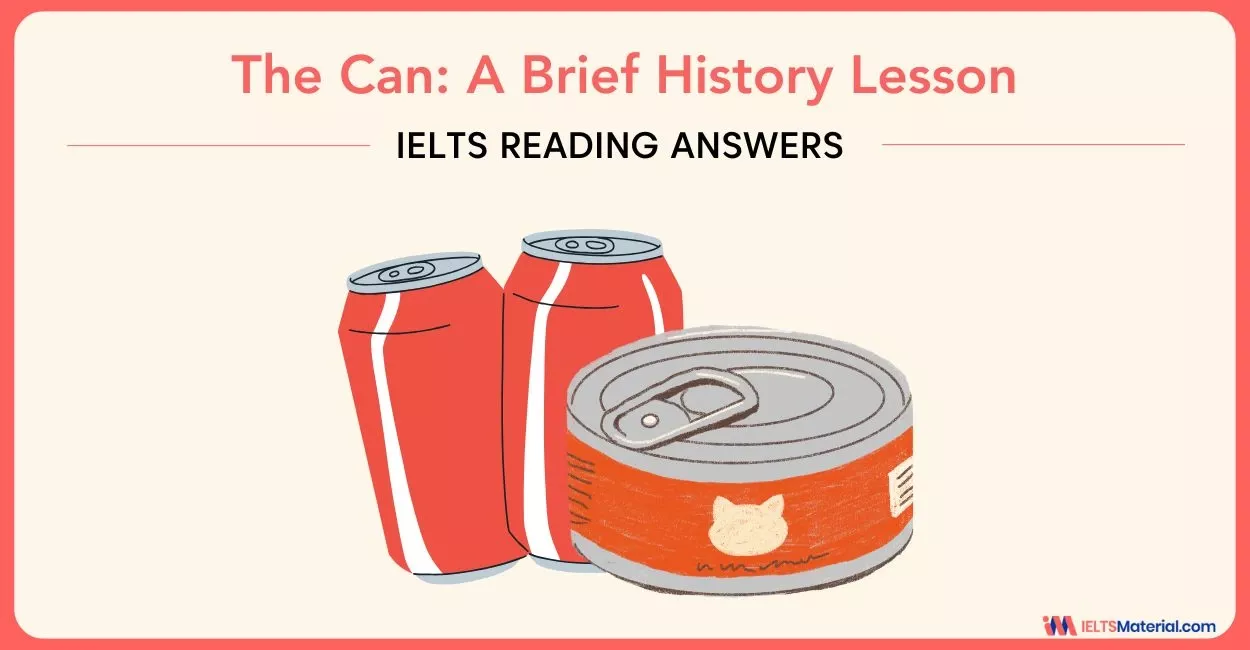The Can: A Brief History Lesson - IELTS Reading Answers
14 min read
Updated On
-
Copy link
Get ready for the IELTS Academic Reading section with topics like ‘The Can: A Brief History Lesson Reading Answers’, and significantly improve your IELTS reading band score. This blog provides tips, answers, and explanations for those aiming for a Band 9.
Table of Contents
- Passage for The Can: A Brief History Lesson IELTS Reading Answers
- Questions for The Can: A Brief History Lesson Reading Answers
- Answers and Explanations of The Can: A Brief History Lesson IELTS Reading Passage
- Tips for Answering the Question Types in the The Can: A Brief History Lesson Reading Passage

Limited-Time Offer : Access a FREE 10-Day IELTS Study Plan!
Besides improving your skimming and scanning skills, you need to master the art of elimination if you want to score high on the reading module of IELTS. It is a powerful tool for IELTS Reading success, especially for tricky multiple-choice and matching questions. To work on all these skills, the most important step is to practice passages like ‘The Can: A Brief History Lesson IELTS Reading Answers’ and eventually take up timed practice of complete tests.
So, take the passage ‘The Can: A Brief History Lesson Reading Answer’ below and try more IELTS reading practice tests. We have provided explanations, locations for the answers, and tips to help you handle the three different types of reading questions here.
Passage for The Can: A Brief History Lesson IELTS Reading Answers
Go through the The Can: A Brief History Lesson IELTS Reading Answers passage given below, and prepare yourself for the reading section with this passage from one of the IELTS recent actual tests.
You should spend about 20 minutes on Questions 27-40, which are based on the Reading Passage below.
The Can: A Brief History Lesson
A The story of the can begins in 1795 when Nicholas Appert, a Parisian, had an idea: why not pack food in bottles like wine? Fifteen years later, after researching and testing his idea, he published his theory: if food is sufficiently heated and sealed in an airtight container, it will not spoil. In 1810 Peter Durand, an Englishman, wanted to surpass Appert’s invention, so he elected to try tin instead of glass. Like glass, tin could be sealed airtight but tin was not breakable and was much easier to handle. Durand himself did no canning, but two other Englishmen, Bryan Donkin and John Hall, used Durand’s patent. After experimenting for more than a year, they set up a commercial canning factory and by 1813 they were sending tins of food to British army and navy authorities for trial.
B Perhaps the greatest encouragement to the newborn canning industry was the explosion in the number of new colonial territories. As people and goods were being transported to all parts of the world, the canning industry itself was growing in new territories. Englishmen who emigrated to America brought their newfound knowledge with them. One of these was Thomas Kensett, who might fairly be called the father of the can manufacturing industry in the United States. In 1812 he set up a small plant on the New York waterfront to can the first hermetically sealed products in the United States.
C Just before the Civil War, a technical advance by canners enabled them to speed up production. Adding calcium chloride to the water in which cans were cooked raised the water temperature, speeding up the canning process. Also for almost 100 years, tin cans were made by artisans by hand. It was a laborious process, requiring considerable skill and muscle. As the industrial revolution took hold in the United States, the demand for cans increased and machines began to replace the artisans’ handiwork. A good artisan could make only 10 cans a day. True production progress in can-making began in 1922 when American engineers perfected the body-making process. New methods soon increased the production of cans to as many as 250 a minute.
D As early as 1940, can manufacturers began to explore the possibility of adapting cans to package carbonated soft drinks. The can had to be strengthened to accommodate higher internal can pressures created by carbonation (especially during warm summer months), which meant increasing the thickness of the metal used in the can ends. Another concern for the new beverage can was its shelf life. Even small amounts of dissolved tin or iron from the can could impair the drinking quality of drinks. Also the food acids, including carbonic, citric and phosphoric, in soft drinks presented a risk for the rapid corrosion of exposed tin and iron in the can. At this point the can was upgraded by improving the organic coatings used to line the inside. The can manufacturers then embarked on a program of material and cost savings by reducing both the amount of steel and the amount of coating used in can making. These efforts were in part inspired by a new competitor – aluminium.
E Beverage cans made from aluminum were first introduced in 1965. This was an exciting innovation for the packaging industry because the aluminum can was made with only two pieces – a body and an end. This made production easier. Some of the reasons for the aluminum can’s acceptance were its ductility, its support of carbonation pressure, its lighter weight and the fact that aluminum does not rust. Both steel and aluminum cans used an easy-open end tab but the aluminum tab was much easier to make. Perhaps the most critical element in the aluminum can’s market success was its recycling value. Aluminum can recycling excelled economically in the competition with steel because of the efficiencies aluminum cans realized in making new cans from recycled materials compared with 100 percent virgin aluminum. Steel did not realize similar economies in the recycling process.
F Prior to 1970, can makers, customers and consumers alike were unaware of the impact that the mining and manufacturing of steel or aluminium had on the environment. The concept of natural resource preservation was not an issue of great importance and the low growth of population during these early years further de-emphasized concerns for resource depletion. Both industries, however, came to realize the importance of reducing their impact on the environment in the late 1960s and early 1970s as a new environmentally conscious generation emerged. Manufacturers began to recognize the economics of recycling, namely lower manufacturing costs from using less material and less energy. By the 1980s and 1990s, recycling had become a way of life. Aluminum can recycling has become a billion-dollar business and one of the world’s most successful environmental enterprises. Over the years, the aluminum can has come to be known as America’s most recyclable package, with over 60 percent of cans being recycled annually.
G Advances in can manufacturing technology have also brought us lighter aluminum cans. In 1972, one pound of aluminum yielded only 21.75 cans. Today, by using less material to make each can, one pound of aluminum makes approximately 32 cans – a 47 percent improvement. Just the lightening of can ends makes a huge difference. When you multiply the savings by the 100 billion cans that are made each year, the weight and savings are phenomenal – over 200 million pounds of aluminum!
Questions for The Can: A Brief History Lesson Reading Answers
The Academic Reading passage, The Can: A Brief History Lesson, which is the third text of a complete reading test, comes with 14 questions and showcases three different IELTS Reading question types with examples.
The question types found in this reading passage are:
- IELTS Reading Matching Headings (Q. 27-32)
- IELTS Reading Matching Information (Q. 33-38)
- IELTS Reading True False Not Given (Q. 39-40)
Questions 27 – 32
The reading passage on The Can – A Brief History Lesson has 7 paragraphs A – G. From the list of headings below choose the most suitable headings for paragraphs B – G.
Write the appropriate number (i – xi) in boxes 27 – 32 on your answer sheet.
NB There are more headings than paragraphs, so you will not use them all.
i The Invention of the Aluminum Can
ii Technological Breakihroughs
iii Canning and the Beer Industry
iv The Invention
v Canning and War
vi Further Manufacturing Advances
vii Problems with Spoiled Contents
viii Expansion of the Industry
ix Today’s Uses for Canning
x Drinks Canning
xi Cans and The Environment
27 Paragraph B
28 Paragraph C
29 Paragraph D
30 Paragraph E
31 Paragraph F
32 Paragraph G
Questions 33 – 38
Below are two lists. The first list (questions 33- 38) is a list of dates of events in Reading Passage 3: The Can – A Brief History Lesson. The second list (A – G) is a list of the events. Match the year with the correct event in the history of the can.
Write your answers in boxes 33 – 38 on your answer sheet.
One of the dates and one of the events are matched as an example.
Example Answer
1810 E
| Question | Date |
| EG | 1810 |
| 33 | 1922 |
| 34 | 1812 |
| 35 | 1813 |
| 36 | 1965 |
| 37 | 1813 |
| 38 | 1940 |
EVENTS
A Mass production techniques revolutionized the canning process.
B Tinned food was tested by military authorities.
C Today’s canning material was first introduced.
D The first American canning factory was opened.
E Tin was used in the canning process for the first time.
F The canning of fizzy drinks began.
G The first business canning plant was opened
Questions 39 and 40
Read paragraphs F and G of Reading Passage 3 The Can – A Brief History Lesson again and look at the statements below.
In boxes 39 and 40 on your answer sheet write:
TRUE if the statement is true
FALSE if the statement is false
NOT GIVEN if the information is not given in the text
39-Recycling has helped reduce manufacturing overheads.
40-Aluminium can production costs have fallen by nearly 50% since 1972.
Book a FREE Demo with our experts to learn tricks and techniques to ace the IELTS Reading!
Answers and Explanations of The Can: A Brief History Lesson IELTS Reading Passage
Check out the answer key for this IELTS Academic Reading passage, The Can: A Brief History Lesson, with detailed explanations.
27 Answer: viii
Question type: Matching Heading
Answer location: Paragraph B, line 2 – line 3
Answer explanation: The following line from Paragraph B says that “As people and goods were being transported to all parts of the world, the canning industry itself was growing in new territories.” This indicates that the canning industry was expanding. Hence the answer is viii.
28 Answer: ii
Question type: Matching Heading
Answer location: Paragraph C, line 6 – line 9
Answer explanation: The following lines from Paragraph C say that “True production progress in can-making began in 1922 when American engineers perfected the body-making process. New methods soon increased the production of cans to as many as 250 a minute.” This indicates that technological breakthroughs enabled higher can production. Hence the answer is ii.
29 Answer: x
Question type: Matching Heading
Answer location: Paragraph D, line 1 – line 2
Answer explanation: The following line from Paragraph D says that “As early as 1940, can manufacturers began to explore the possibility of adapting cans to package carbonated soft drinks.” This suggests that cans were used to contain carbonated drinks. Hence the answer is x.
30 Answer: i
Question type: Matching Heading
Answer location: Paragraph E
Answer explanation: Paragraph E talks about the invention of aluminium cans. “Beverage cans made from aluminum were first introduced in 1965.” Thus, the answer is i.
Unlock Explanations
31 Answer: xi
Question type: Matching Heading
Answer location: Paragraph F
Answer explanation: Paragraph F talks about the environmental impact of cans and aluminium cans. The following lines from Paragraph F say that “Prior to 1970, can makers, customers and consumers alike were unaware of the impact that the mining and manufacturing of steel or aluminium had on the environment. The concept of natural resource preservation was not an issue of great importance and the low growth of population during these early years further de-emphasized concerns for resource depletion.” Hence the answer is xi.
32 Answer: vi
Question type: Matching Heading
Answer location: Paragraph G
Answer explanation: The following line from Paragraph G says that “Advances in can manufacturing technology have also brought us lighter aluminum cans.” This indicates that advancement in can-making technology has led to better and lighter cans. Hence the answer is vi.
33 Answer: A
Question type: Matching Information
Answer location: Paragraph C, line 6 – line 8
Answer explanation: The following line from Paragraph C says that “True production progress in can-making began in 1922 when American engineers perfected the body-making process.” Hence the answer is A.
34 Answer: D
Question type: Matching Information
Answer location: Paragraph B, line 5 – line 7
Answer explanation: The following line from Paragraph D says that “In 1812 he set up a small plant on the New York waterfront to can the first hermetically sealed products in the United States.” Hence the answer is D.
35 Answer: B
Question type: Matching Information
Answer location: Paragraph A, line 7 – line 9
Answer explanation: The following line from Paragraph A says that “After experimenting for more than a year, they set up a commercial canning factory and by 1813 they were sending tins of food to British army and navy authorities for trial.” Hence the answer is B.
36 Answer: C
Question type: Matching Information
Answer location: Paragraph E, line 1
Answer explanation: The following line from Paragraph E says that “Beverage cans made from aluminum were first introduced in 1965.” Hence the answer is C.
37 Answer: G
Question type: Matching Information
Answer location: Paragraph A, line 7 – line 9
Answer explanation: The following line from Paragraph A says that “After experimenting for more than a year, they set up a commercial canning factory and by 1813 they were sending tins of food to British army and navy authorities for trial.” Hence the answer is G.
38 Answer: F
Question type: Matching Information
Answer location: Paragraph D, line 1 – line 2
Answer explanation: The following line from Paragraph D says that “As early as 1940, can manufacturers began to explore the possibility of adapting cans to package carbonated soft drinks.” Hence the answer is F.
39 Answer: True
Question type: True/False/Not Given
Answer location: Paragraph F, line 7 – line 8
Answer explanation: The following line from Paragraph D says that “Manufacturers began to recognize the economics of recycling, namely lower manufacturing costs from using less material and less energy.” Hence the answer is True.
40 Answer: Not Given
Question type: True/False/Not Given
Answer location: N.A
Answer explanation: The following lines from Paragraph G say that “Advances in can manufacturing technology have also brought us lighter aluminum cans. In 1972, one pound of aluminum yielded only 21.75 cans.” However, it is not mentioned in the passage that aluminium can production costs have fallen by nearly 50% since 1972. Thus, the answer is Not Given.
Learn quick solving tips and reading techniques from experts!
Connect with us through our FREE IELTS online classes!
Tips for Answering the Question Types in the The Can: A Brief History Lesson Reading Passage
Let us check out some quick IELTS exam preparation tips for band score of 8+ and to answer the types of questions in the ‘The Can: A Brief History Lesson Reading Answers’.
Matching Headings
- Read the first 2 lines and the last line of each paragraph: The main idea of a paragraph almost always appears in these spots. For example: Paragraph B begins with ‘As people and goods were being transported…’, which refers to an expansion idea, and leads to Heading ‘viii’ (Expansion of the Industry).
- Ignore examples and details: Do not get distracted by lists of dates, names, or processes. IELTS headings focus on the central idea, not the supporting evidence.
- Identify key themes of each paragraph: Each paragraph of this passage has a clear focus transition. For example, B refers to growth/expansion, C refers to breakthroughs/production advances, D refers to cans for soft drinks, E talks about aluminium invention, F is about environmental concerns and G refers to further improvements.
- Use synonym linking between headings and text: IELTS passages never repeat exact words. So, spot synonym patterns, like ‘Technological breakthroughs’ (new methods), ‘perfection of process’ (C); ‘Further manufacturing advances’ (advances in can manufacturing technology’ (G); ‘Cans and the Environment’ (impact on the environment’ (F).
- Eliminate similar headings by time focus: Two headings may sound similar, like ‘Technological Breakthroughs’ and Further ‘Manufacturing Advances’. In such cases, use chronology to decide. For example,
- Earlier paragraphs = invention or breakthroughs (C)
- Later paragraphs = further advances (G).
- Always double-check: Even though you are confident about an option, it is safe to double-check as sometimes the same option might be more relevant to another question.
Matching Information
- Underline all years in the passage first and keep chronology in mind: Quickly scan the entire passage and highlight years (1810, 1812, 1813, 1922, 1940, 1965, 1972). This instantly gives you the idea of the timeline. Moreover, IELTS passages usually order these dates in the same sequence as the passage. So, scanning top-to-bottom of the text is faster than random jumping.
- Read around each year: Make sure to read both before and after the sentence as IELTS passages sometimes give context before the date. For example: In ‘True production progress in can-making began in 1922…’, the main idea is mass production breakthroughs (A).
- Watch for repeated years or dual mentions (like 1813): 1813 is linked with both trial by army and factory setup, so read carefully which action the question refers to. The key is to spot verbs like ‘tested’, ‘opened’, ‘sent to army’.
- Match by logic, not guesswork: If the passage says ‘In 1965, beverage cans made from aluminium were first introduced’, then match with ‘C – Today’s canning material was first introduced’, not with a vague ‘technological advance’.
- Don’t mix Up similar processes: Always focus on the main event of that year. For example, ‘Factory opened’ is not the same as ‘factory tested’.
True/False/Not Given
- Read the statement word-by-word: It will help you to identify key claims and quantifiers.
- Locate keywords, not synonyms: Look for exact ideas like ‘recycling’, ‘manufacturing costs’, ‘aluminium production’ in paragraphs F–G.
- Beware of distractors: IELTS passages add fake percentages or years to distract you from the correct option. So, if a statement mentions ‘nearly 50%’, check if that specific figure exists in the text; if not, the answer is ‘NOT GIVEN’.
- Do not confuse inference with evidence: If the passage says recycling ‘lowers costs’, that supports TRUE. But if it only says cans are lighter, it does not mean costs fell. So, the answer will be ‘NOT GIVEN’.
- Read the entire sentence around the keyword: Sometimes the first part seems to confirm it, but the next line reverses the meaning. For example, ‘Manufacturers began to recognize the economics of recycling…’. It directly confirms Q. 39 as ‘TRUE’.
To conclude, IELTS reading samples, such as The Can: A Brief History Lesson IELTS Reading Answers are crucial. They will assist you in improving your reading speed, identifying your areas of weakness, and getting more used to the many kinds of reading questions. Thus, keep solving similar IELTS Reading topics for General and Academic for the reading section and get the outcomes you want.
Useful Links:
- A Brief History of Tea IELTS Reading Answers
- The History Of The Poster - IELTS Reading Answers
- A Brief History of Automata Reading Answers
- Learning About The Past - IELTS Reading Answers
- Making the Most of Trends IELTS Reading Answers
- Best IELTS Reading Books 2025
- How to Ace IELTS Reading with 'Keyword Technique'
Practice IELTS Reading based on question types

Start Preparing for IELTS: Get Your 10-Day Study Plan Today!
Explore other Reading Actual Tests
Nehasri Ravishenbagam

Kasturika Samanta

Nehasri Ravishenbagam

Nehasri Ravishenbagam
Recent Articles

Nehasri Ravishenbagam

Haniya Yashfeen

Haniya Yashfeen

Haniya Yashfeen




Post your Comments